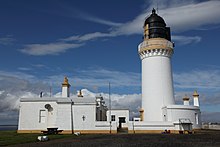Noss Head Lighthouse
 Noss Head in 2011 | |
 | |
| Location | Wick, Highland |
|---|---|
| OS grid | ND3881255012 |
| Coordinates | 58°28′44″N 3°03′03″W / 58.479°N 3.05092°W |
| Tower | |
| Constructed | 1849 |
| Designed by | Alan Stevenson |
| Automated | 1987 |
| Height | 18 metres (59 ft) |
| Operator | Northern Lighthouse Board |
| Heritage | category A listed building |
| Light | |
| First lit | 1849 |
| Focal height | 53 metres (174 ft) |
| Lens | second order Fresnel lens |
| Range | 25 nautical miles (46 km; 29 mi) |
| Characteristic | Fl WR 20s |
The Noss Head Lighthouse is an active 19th century lighthouse near Wick in Caithness in the Highland council area . It is located at the end of Noss Head, a peninsula on the north-west coast of Caithness that overlooks Sinclairs Bay three miles north-east of Wick. It is notable as being the first lighthouse that was built with a diagonally paned lantern room.
History
The need for the lighthouse was promoted by the Northern Lights Commissioners, and the light first entered service in 1849, and consists of an 18m high cylinder-shaped tower, which is painted white. It supports a single gallery and a lantern with a black cupola. There are 76 steps to the top of the tower.[1] Adjacent to the tower are a pair of keeper’s cottages and subsidiary buildings, bounded by a walled compound.[2]
The lighthouse was built by Mr Arnot of Inverness, with the construction being overseen by the notable lighthouse engineer Alan Stevenson, who for the first time used diagonal glass panes and framing for the exterior lantern. Considered to be both stronger, and less likely to interrupt the light from the optic, the design was employed as the standard for all future lighthouses built by the Board.[1]
As a way to provide work for those local people who had been affected by the Highland potato famine, and needed Poor Relief, labourers were hired at a rate of 3s/6d per day (£21 as of 2024)[3] to construct an access road from Wick to the lighthouse.[1][4]
In 1987 the light was converted to automatic operation, and the keeper’s cottages were sold and are now used by the Clan Sinclair Trust as a study centre for research into the clan's history. The main keeper’s house and one of the cottages have also been converted to holiday accommodation.
Following automation, the original Fresnel lens and mechanical drive train from the lighthouse were removed, and are now exhibited on two floors of the Wick Heritage Centre, one of the few from this period that is still in full working order.[5]
Operational details
With a focal height of 53m above sea level, the light can be seen for 25 nautical miles. Its light characteristic is made up of a flash of light every twenty seconds. The colour being white or red, varying with direction.[2][1] The light and tower is maintained by the Northern Lighthouse Board, and is registered under the international Admiralty number A3544 and has the NGA identifier of 114-3012.[2]
Listed buildings
The entire station including the tower, keeper’s cottages and outhouses are protected as a category A listed building, and considered to be of national or international importance.[6][7]
See also
References
- ^ a b c d "Noss Head Lighthouse". Northern Lighthouse Board. Retrieved 25 January 2016.
{{cite web}}: Cite has empty unknown parameter:|1=(help) - ^ a b c Rowlett, Russ. "Lighthouses of Scotland: Highlands". The Lighthouse Directory. University of North Carolina at Chapel Hill. Retrieved 25 January 2016.
- ^ UK Retail Price Index inflation figures are based on data from Clark, Gregory (2017). "The Annual RPI and Average Earnings for Britain, 1209 to Present (New Series)". MeasuringWorth. Retrieved May 7, 2024.
- ^ Treasury (1847). Correspondence from July, 1846, to February, 1847, Relating to the Measures Adopted for the Relief of the Distress in Scotland... W. Clowes & sons. pp. 164–.
- ^ "Lighthouse". Wick Heritage Museum. Retrieved 25 January 2016.
- ^ "Noss Head Lighthouse: Listed Building Report". Historic Environment Scotland. Retrieved 25 January 2016.
- ^ Historic Environment Scotland. "Noss Head Lighthouse (9112)". Canmore. Retrieved 7 February 2016.
